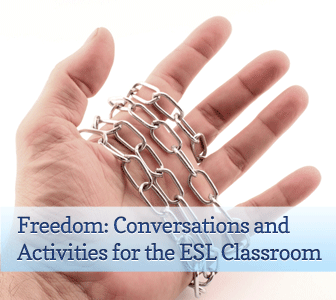For citizens of the United States, our freedoms are an important characteristic of our lives. Most everyone knows that the freedom of life, liberty and the pursuit of happiness are part of the American dream, but not everyone thinks of freedom in the same manner.
Cultural perceptions about what it means to be free vary, but teachers of ESL have an opportunity to turn those cultural values into productive language lessons. ESL classes, which often have students from every corner of the globe, are sure to have interesting conversations when it comes to talking about freedom.

How to Talk about Freedom in Your ESL Classroom
-
1
What is Freedom Worth
What is freedom worth to you and to your students? Would you give a year of service to your country for your freedom? Would you give a lifetime of service? Would you give your very life? Put your students into discussion groups, trying to have as many different nations represented in the group as possible. Give your students these questions and challenge them to have an open discussion with one another. What have members of the group already given for their freedom? See if the group can write a definition of the word ‘freedom’ on which everyone can agree keeping in mind their answers to the discussion questions.
-
2
Roosevelt’s Four Freedoms
Taking the discussion a bit further, introduce your students to what Franklin Roosevelt talked about in his State of the Union address in January of 1941. He said that every American has four basic freedoms: freedom of speech, freedom of religion, freedom from want and freedom from fear. Ask these discussion groups to talk about how each of those freedoms affects their lives both in the United States as well as in their home countries. If your students are studying in places other than the United States, what do they think those freedoms might look like in the U.S.? After groups have discussed the freedoms, ask each group to choose one of them and create a poster in which they draw a representation of the freedom in their lives. They may choose to a poster with one message or create a mural with many ideas depicted. In either case, display those posters around your classroom when they are complete and allow your students to see how their classmates portrayed freedom.
-
3
Symbols of Freedom
In the United States, some of the most popular symbols of freedom are the eagle, the flag, the Statue of Liberty and the Liberty Bell. Send your students to the internet, either individually or in groups, to research how each of these objects became symbols of freedom in the United States. Then challenge students to list some objects that are used in their home countries as symbols of freedom. Are there similarities? Why or why not? After each person has enough information, have him write a piece explaining what symbolizes freedom to him. It may be some of the objects he researched, or it may be something completely different. Ask your students to illustrate their compositions and then post them together on a bulletin board with the title “What Freedom Looks Like”.
-
4
Running for Freedom
The Underground Railroad was used in the United States by southern slaves who ran away seeking freedom in the north. Free individuals would provide food and shelter to these runaways on their journey to freedom even though if the runaway slaves were caught those that harbored them would have been punished by the authorities. Give your students some information about the Underground Railroad or send them to the library or internet to do their own research. Once they have a better idea about what it meant to help these escapees, ask your students to think about this question: would you risk your freedom and break the law to help a person you did not know find freedom from slavery? Give each person some time to prepare his thoughts and support for his point of view and then ask willing students to speak in front of the class, sharing their thoughts.
-
5
Freedom to Love
Another topic which some people say questions the freedom of an individual is the idea of prearranged marriage. Many people today feel that a man or woman should be able to choose his or her own spouse, but that was not always the case. In times past, prearranged marriage was the dominant method of the day. Put your students into discussion groups to make a list of pros and cons about prearranged marriage. Do your students think that prearranged marriage is an infringement on an individual’s freedom? Ask each person to imagine that he or she has been found a mate through arranged marriage. He has never met her and she has never met him, but they are allowed to write letters to one another before they meet on the wedding day. Ask each person to write a letter to a future spouse that he or she knows nothing about. In the letter, each person can decide to go through with the marriage or try to call it off. Either way, challenge your students to be creative in what they write and careful about how they write it.
Freedom is an important issue that touches our daily lives, though we may forget that from time to time.
Challenge your students to think about what freedom means to them and what freedom is worth to them. Through these exercises and activities that focus on freedom, your students will have to think again what their freedom means to them.
P.S. If you enjoyed this article, please help spread it by clicking one of those sharing buttons below. And if you are interested in more, you should follow our Facebook page where we share more about creative, non-boring ways to teach English.







